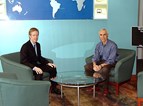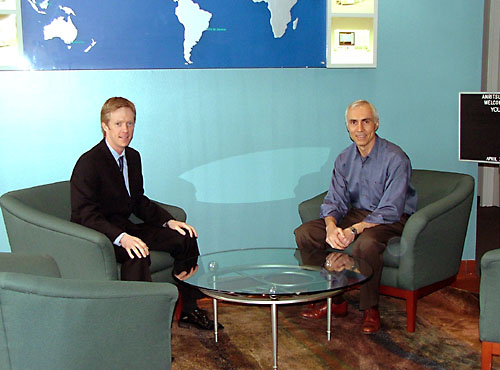Q&A With Anritsu Company President Frank Tiernan

By Jim Pomager
Senior Editor
During a recent visit to the San Francisco area, I was privileged to spend some time with Frank Tiernan, president of Anritsu Company, at the company's U.S. headquarters in Morgan Hill, CA. Tiernan, whose career in test and measurement (T&M) spans more than 25 years, was about to celebrate his first anniversary as president of the company. (He was named president of Anritsu Company and VP of Anritsu Corporation, the company's Japan-based parent, in April 2004. See related story.)
Before becoming president of Anritsu Company, Tiernan served as general manager of Anritsu's Microwave Measurement Division (MMD), during which time he helped develop some of Anritsu's most successful products, including the Scorpion Vector Network Measurement System (VNMS), the Lightning Vector Network Analyzer (VNA) family, and the Site Master line of cable and antenna analyzers. Prior to his term as general manager, Tiernan held a number of other management positions within MMD. Tiernan joined Anritsu in 1990, when the company acquired test manufacturer Wiltron Company, where he began his career in the early 1970s.
With 25 years in the T&M industry under his belt, Tiernan has witnessed a lot of growth and change in both T&M and the electronics field in general. During our lively conversation, Tiernan expressed his views on the current state of T&M in the RF/microwave field, talked about his new boss, highlighted some of Anritsu's successes under his watch, and covered some new and soon-to-be released Anritsu products.

RF Globalnet editor Jim Pomager (left) meets with Anritsu president Frank Tiernan at Anritsu's U.S. headquarters.
RF Globalnet (RFG): When you were named president of Anritsu Company about this time last year, you stated that one of your goals was to "position Anritsu as a leader in the test and measurement community" serving the microwave/RF space. In your first year as president, how would you rate your progress relative to that goal?
Frank Tiernan (FT): One of the definitions of a leader is someone whom people are following. In terms of the products Anritsu has introduced in the last year, I'm pleased to say that, not only have the technologies received a good response from the industry, but we're seeing some of our competitors start to adopt them as well. I think we've made some nice progress in that regard.
RFG: What products, specifically, do you feel have garnered the most interest, both from the market and from your competitors?
FT: Certainly the Signature Signal Analyzer is one that is at the forefront of technology. We have, I think, set a new standard with the integration of simulation and instrumentation, as well as with the use of the Windows® operating system. Other T&M companies have used Windows before, but it's been a "closed" system -- users couldn't really access it as they could a PC. In Signature's case, it's a fully open system -- you can put other applications on it. This is one of those areas where we see signs of other companies starting to follow along.
Another area where we have really taken a leadership position is in very high microwave. Our V Connector, a 110 GHz coaxial connector, is at the forefront of technology and is helping people make very broadband coaxial measurements. Before this connector, they had to use waveguide and banded types of measurements.
Prior to this year, we were probably most recognized in the handheld field service, installation, and maintenance space for the cellular market. In the last year, we have not only maintained but also furthered our leadership in that market by bringing more functionality to base station test, both for cdma2000-type protocols and also W-CDMA. We produced the Cell Master B, which offers testing for 1xEV-DO. For W-CDMA service providers, we recently introduced the UMTS Master, which brings W-CDMA measurement capability to people who maintain and install base stations.
RFG: You mentioned Signature, which made a big splash when it was introduced at the IEEE MTT-S International Microwave Symposium last year. What does the future hold for this platform?
FT: Signature is a very powerful, versatile, and broad platform, to which we are aggressively adding functionality, including enhancements in RF performance, additional communication protocol testing, and things of that nature. It's an evolutionary process, and I think the platform will support us very well in the years to come. You should hear more about Signature improvements the midyear time frame.
RFG: We recently learned that Hiromichi Toda was appointed president of Anritsu Corporation (see related story). Tell me about the impact he will have when he assumes the position in June.
FT: I was very pleased by that announcement. I have known Toda-san for a number of years, and I have a lot of respect for him. He is very strong technically -- earlier in his career, he managed the group that developed digital global radio test equipment that was very well received in the industry. He is a very capable manager, and I am very comfortable with his style. I think he is going to be a good leader for Anritsu.
RFG: Do you see his appointment impacting the U.S. business?
FT: I think Toda-san understands the importance of the U.S. market. Anritsu is headquartered in Japan, and early in its history the company was fairly Japan-centric, to be honest. Anritsu now recognizes that T&M is a global market, and one of the ways we want to strengthen our position is by taking the success and the advantages that we have in Japan and applying them worldwide. I think Toda-san will help us achieve that.
RFG: Anritsu has launched a flurry of new products over the past few months. Which one has you the most excited?
FT: That's like asking me which one of my children I like the best! There are a number of them, really...
We have a new signal generator, the MG3700, which comes from one of the Japanese divisions. It can play back very complex modulation schemes. You provide it with a digital record, if you will, of what you want it to generate, and it generates it. And it's a good fit with Signature -- you can capture a signal with Signature and then play it back through the MG3700 and add functionality as well. It's a very versatile box.
I'd be remiss if I didn't mention the MS2721, a handheld spectrum analyzer that covers DC to 7 GHz -- benchtop-level performance in a handheld package. And the basic analyzer can be adapted for a broad range of applications. One of our Japanese divisions, for instance, used it in digital broadcasting for NHK [Japan Broadcasting Corporation]. Analog spectrum analyzers were incapable of making constellation pattern and other measurements NHK needed. So we worked with the Japanese division to add that functionality to this basic spectrum analyzer platform.
Can I pick one more? We had a nice addition to our VNA line in the 37000D. It is part of an area where we have really differentiated ourselves -- very broadband vector network analyzer measurements, basically from DC to 110 GHz. People are interested in this for characterizing semiconductor devices and, surprisingly, for characterizing passive devices. You wouldn't think measuring a resistor up to 110 GHz would be of much interest, but people who are designing MMICs [monolithic microwave integrated circuits] often incorporate resistor elements and capacitive elements. If their MMICs are going to operate at high frequencies, they need to understand and model those passives.
RFG: At CTIA Wireless last month, one of the trends I noticed was a push by T&M companies to cover as many stages of the "wireless life cycle" as possible -- from component test, to device test, to system test, to network optimization and maintenance. Is this sort of diversification important to Anritsu? Does the company plan to pour more resources into any particular stage in the process?
FT: Anritsu is not a niche company. We have a broad base of capabilities, which is reflected in our product line. We supply power meters, signal generators, vector network analyzers, and spectrum analyzers. We are strong in field installation and maintenance. And we are strong in the high-end R&D space, as well.
We are not as strong in applying the benchtop instrument to manufacturing. That is probably because our products tend to be high-end, and in manufacturing, people are often looking for lower-cost solutions. We are exploring ways to improve our presence in manufacturing, but we will not do it at the expense of high-end R&D.
At this point, we are not involved in semiconductor test. Some companies have migrated toward this area, and we have partnered with some of them on an OEM basis to supply measurement engines. However, semiconductor test is not currently part of our strategic plans.
RFG: Which wireless specification will grab the most headlines in the next 12 months?
FT: I think it's going to be interesting, particularly in the United States. There has been a great deal of consolidation in the cellular space -- we are down to about five major service providers. And there are two dominant protocols -- CDMA and W-CDMA. Each will try to outdo the other in terms of providing functionality and features to the end user. However, I don't think one will necessarily come out on top. The two of them will compete, which will be better for the consumer, because they will get increased functionality at a lower price.
In a way, the competition is good for T&M, because there are more requirements. Competition also tends to push the technology envelope, and when companies are pushing the technology envelope, they need new and different T&M functionality than they did before. So, in a way, it works to our advantage and the consumer's advantage.
RFG: If you could get one message out to the RF/microwave design community, what would it be?
FT: Really, I think we should reverse the question (laughing)! We should be listening to the RF and microwave user community. It's our job to understand what they need, the problems they have... and then provide tools that help them achieve their objectives. If we can do that, then we can be successful.
